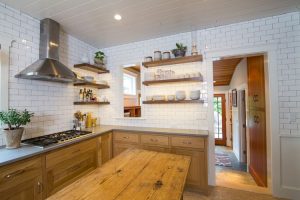As we strive to create a healthier planet and a more sustainable future, it is important to consider sustainable materials when designing an eco-friendly home.
Here are four eco-friendly materials we think you should know about when designing your home.
Recycled Glass: Recycled glass is a sustainable material made from previously used glass that is crushed, blended and remelted with sand, soda ash and limestone. Recycled glass can help reduce emissions and greenhouse gasses and has many uses when it comes to interior design. From kitchen countertops, sustainable lighting fixtures, glass backsplashes and glass wool insulation, recycled glass offers eco-friendly options that add personality to any space.
Bamboo: Bamboo is a fast-growing sustainable grass part of the evergreen grass family, Poaceae, which is native to tropical, sub-tropical and temperate climates around the world. Bamboo is a durable and eco-friendly material that helps decrease deforestation, reduces up to 35% of carbon dioxide, delivers oxygen and helps reduce water pollution by consuming high volumes of nitrogen in the ecosystem. Bamboo has many uses for interiors and exteriors of homes, which include fencing, paneling, rugs, furniture, window treatments, light fixtures and floors. Since bamboo is smooth, durable and resistant to shrinking or swelling, it makes it a great material for flooring. Bamboo can also be stained or left with its natural finish and can add a natural, earthy presence to any home.
Reclaimed Wood: Reclaimed wood is essentially old wood that has been salvaged and repurposed without the need to cut any new trees down. Using reclaimed wood from old barns or factory buildings can help prevent deforestation by reducing the consumer’s demand for new lumber. Reclaimed wood is often loved by interior designers because of its unique grain patterns and sense of visual appeal. A great and easy way to repurpose reclaimed wood is to transform it into a bookshelf or wine rack, which can add some character and uniqueness to your home!
Cork: Cork is a natural, reusable and recyclable material that comes from the outer bark of the cork oak tree which is harvested every 9-12 years and primarily found in the Mediterranean countries of Italy, Spain and Portugal and Northern Africa. While cork is generally associated with wine bottles, it can also be used for flooring, walls, insulation and accessories such as hanging pendant lights. Cork is one of the best sustainable materials a designer can use in a space due to its waterproof, fire retardant, and antimicrobial abilities, as cork’s anti-static surface eliminates the absorption of dust and toxins. Cork is more water resistant than hardwood which makes for a good flooring option, and does not cause damage to the tree when harvested.
To learn more about the benefits of these materials from a professional architect and designer’s perspective, consider booking a free consultation with Amy here!



